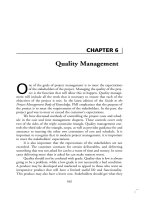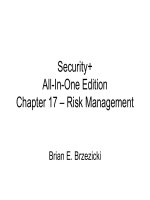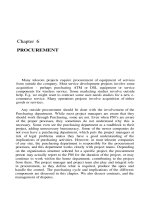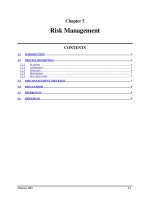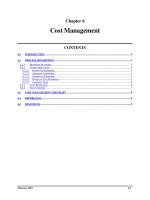Chapter 6 risk management
Bạn đang xem bản rút gọn của tài liệu. Xem và tải ngay bản đầy đủ của tài liệu tại đây (3.16 MB, 37 trang )
Source: Mc Graw Hill Education. All Rights Reserved, 2021
CHAPTER 6:
RISK MANAGEMENT
© 2021 McGraw-Hill Education. All rights reserved. Authorized only for instructor use in the classroom.
No reproduction or further distribution permitted without the prior written consent of McGraw-Hill Education.
2
Risk Management Process
• Risk
–Uncertain or chance events that planning can not overcome
or control.
• Risk Management
–A proactive attempt to recognize and manage internal
events and external threats that affect the likelihood of a
project’s success.
• What can go wrong (risk event).
• How to minimize the risk event’s impact (consequences).
• What can be done before an event occurs (anticipation).
• What to do when an event occurs (contingency plans).
3
The Risk Event Graph
FIGURE 7.1
4
Risk Management’s Benefits
• A proactive rather than reactive approach.
• Reduces surprises & negative consequences.
• Prepares the project manager to take advantage of
appropriate risks.
• Provides better control over the future.
• Improves chances of reaching project performance
objectives within budget & on time.
5
The Risk
Management
Process
FIGURE 7.2
6
Managing Risk
• Step 1: Risk Identification
–Generate a list of possible risks through brainstorming,
problem identification and risk profiling.
• Macro risks first, then specific events
• Step 2: Risk assessment
–Scenario analysis
–Risk assessment matrix
–Failure Mode & Effects Analysis (FMEA)
–Probability analysis
• Decision trees, NPV, and PERT
–Semi-quantitative scenario analysis
7
Partial Risk Profile for
Product Development Project
FIGURE 7.3
8
Risk Assessment Form
FIGURE 7.6
9
Risk Severity Matrix
User
Backlash
Interface
problems
System
freezing
Hardware
malfunctioning
FIGURE 7.7
10
Risk Schedules
FIGURE 7.
11
Managing Risk (cont’d)
• Step 3: Risk Response Development
–Mitigating Risk
• Reducing the likelihood an adverse event will occur.
• Reducing impact of adverse event.
–Transferring Risk
• Paying a premium to pass the risk to another party.
–Avoiding Risk
• Changing the project plan to eliminate the risk or condition.
–Sharing Risk
• Allocating risk to different parties
–Retaining Risk
• Making a conscious decision to accept the risk.
12
Contingency Planning
• Contingency Plan
–An alternative plan that will be used if a possible foreseen risk
event actually occurs.
–A plan of actions that will reduce or mitigate the negative impact
(consequences) of a risk event.
• Risks of Not Having a Contingency Plan
–Having no plan may slow managerial response.
–Decisions made under pressure can be potentially dangerous and
costly.
13
Risk Response Matrix
FIGURE 7.8
14
Risk and Contingency Planning
• Technical Risks
–Backup strategies if chosen technology fails.
–Assessing whether technical uncertainties can be
resolved.
• Schedule Risks
–Use of slack increases the risk of a late project finish.
–Imposed duration dates (absolute project finish date)
–Compression of project schedules due to a shortened
project duration date.
15
Risk and Contingency Planning (cont’d)
• Costs Risks
–Time/cost dependency links: costs increase when problems
take longer to solve than expected.
–Deciding to use the schedule to solve cash flow problems
should be avoided.
–Price protection risks (a rise in input costs) increase if the
duration of a project is increased.
• Funding Risks
–Changes in the supply of funds for the project can
dramatically affect the likelihood of implementation or
successful completion of a project.
16
Contingency Funding and Time Buffers
• Contingency Funds
–Funds to cover project risks—identified and unknown.
• Size of funds reflects overall risk of a project
–Budget reserves
• Are linked to the identified risks of specific work packages.
–Management reserves
• Are large funds to be used to cover major unforeseen risks (e.g.,
change in project scope) of the total project.
• Time Buffers
–Amounts of time used to compensate for unplanned delays
in the project schedule.
17
Contingency Fund Estimate (000s)
TABLE 7.1
18
Managing Risk (cont’d)
• Step 4: Risk Response Control
–Risk control
• Execution of the risk response strategy
• Monitoring of triggering events
• Initiating contingency plans
• Watching for new risks
–Establishing a Change Management System
• Monitoring, tracking, and reporting risk
• Fostering an open organization environment
• Repeating risk identification/assessment exercises
• Assigning and documenting responsibility for managing risk
19
Change Management Control
• Sources of Change
–Project scope changes
–Implementation of contingency plans
–Improvement changes
20
Change Management Control
• The Change Control Process
–Identify proposed changes.
–List expected effects of proposed changes on schedule & budget.
–Review, evaluate, & approve or disapprove of changes formally.
–Negotiate and resolve conflicts of change, condition, and cost.
–Communicate changes to parties affected.
–Assign responsibility for implementing change.
–Adjust master schedule & budget.
–Track all changes that are to be implemented
21
The Change Control
Process
FIGURE 7.8
22
Benefits of a Change Control System
1.
Inconsequential changes are discouraged by the formal process.
2. Costs of changes are maintained in a log.
3.
Integrity of the WBS and performance measures is maintained.
4.
Allocation and use of budget and management reserve funds are
tracked.
5.
Responsibility for implementation is clarified.
6. Effect of changes is visible to all parties involved.
7.
Implementation of change is monitored.
8.
Scope changes will be quickly reflected in baseline and
performance measures.
23
Change Request
Form
FIGURE 7.9
24
Change
Request Log
FIGURE 7.10
25

